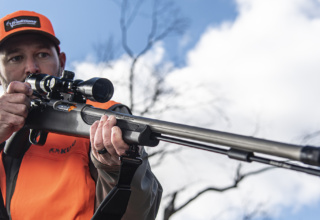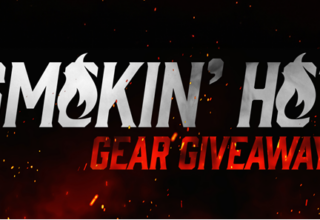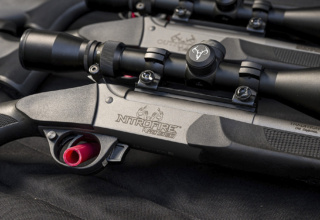Muzzleloaders offer hunters the opportunity to extend their hunting season and put more meat in the freezer—all while improving their hunting and shooting skills. If you want to open a new chapter in your hunting adventures, here’s what you need to know…
by Rob Reaser
I’m no different than most hunters and shooters in that I enjoy the performance advantages of the latest outdoor gear technology. Advances in firearm technology and the explosion of aftermarket upgrades, for example, have put precision long-range shooting in the hands of more enthusiasts than ever. Similarly, more reliable hunting gear, increasingly sophisticated apparel, and other ancillary technology have made hunters more effective in their pursuit of big game. That’s not to say that the animals we hunt still don’t have an overwhelming advantage on us, but things have certainly become a bit easier and more comfortable over the years.
There is, though, an ever-lurking downside to all this. Hunters hunt for many reasons, and personal challenge ranks high among those factors. When things get too easy and the outcomes too predictable, relatively speaking, boredom can set in.
Some hunters are perfectly happy sitting in their box blind on the edge of an ag field, year after year. They know that deer will pop out of the woods at a certain spot at a certain time with clockwork precision, and that their rifle is dialed-in precisely for a one-shot drop. The outcome is foretold. They just show up and go through the motions.
That’s fine, if that’s your style. For most hunters, however, the pursuit is what matters. Sure, they want to fill their tags, but on-the-ground excitement, the unpredictability of the chase, the close-quarter encounter, and the challenge of making your one-shot opportunity count because you may not get another chance is what gets the adrenaline pumping. For the firearm-oriented deer hunter, nothing delivers this level of excitement like hunting with a muzzleloader.
Those of you who enjoy hunting with a muzzleloader already know the thrill and excitement that comes from this game. You also know that the muzzleloader season in your state adds more opportunities to not only hunt deer beyond the traditional buck rifle season but also to be in the woods at a time when things are quieter and hunting pressure has plummeted. If you hunt public land, there’s no better time to be out than during the muzzleloader season because there’s a good chance you’ll have your pick of hunting areas and the deer will have settled down now that the blaze orange masses have left the field.
So, what does it take to start hunting with a muzzleloader? That’s the big question first-timers face, and it can be a daunting prospect if you haven’t been around someone who does it. Fortunately, the needs are few…
Rifle
Do an Internet search for muzzleloaders and you may be surprised at the vast choices that are out there. You might also be a tad confused when viewing some of the newest models on the market since, visually, the line between single-shot centerfire rifles and conventional muzzleloader rifles look quite blurred. That’s because modern in-line muzzleloaders have most of the same features and profile of single-shot centerfire rifles (the break-action variety, anyway). You’ll see ergonomic stocks with plush rubber recoil pads, hammer-fired actions with trigger safeties, optic mounts along the top of the receivers, and removable forends that look no different than that of the centerfire rifles in your gun cabinet.

The difference, of course, is that all muzzleloaders load their charge from the muzzle to the breech, not the other way around.
Should you fancy going completely old-school (which a lot of muzzleloader hunters do), there are many traditional muzzleloaders to choose from with classic percussion cap or flint sidelocks. These rifles perform no different than their modern counterparts as far as loading goes—pour a powder charge down the barrel, followed by a conical lead bullet or round lead ball nestled in a cotton patch, and seat firmly. The difference is in how the powder charge ignites. Sidelocks use an external ignition system, wherein the powder charge receives a spark that travels from the ignited percussion cap or flint-ignited powder through a flash channel. By contrast, inline muzzleloaders have their flash channel at the back of the breech. Ignition comes from a shotgun-type primer seated in the breech plug that is struck by a hammer/firing pin system—hence the term “in-line.”
Although beginner muzzleloader hunters can opt for either conventional or classic ignition rifles, the simplicity of in-line muzzleloaders, with their screw-out breech plugs and familiar hammer/safety configuration, significantly shortens the learning curve and makes the cleanup process quicker and easier.
Our advice is to talk with a friend who is already into muzzleloaders and let them run through the operation before you decide. Lacking that, grab a knowledgeable sales assistant at your local gun store. They should be able to give you a good understanding of the inlines they offer and set you up with one that fits your needs and comfort level.
Propellant
Regardless of your choice of rifle—conventional in-line or sidelock—the propellant used is the same. Many traditional muzzleloader hunters opt for black powder (an explosive), and you can use black powder in a modern inline rifle. It’s what we use in our percussion cap and flintlock rifles, but black powder does require special attention to cleaning. It’s exceptionally dirty yet cleans up well with soap and hot water. Being an explosive, it is also hard to come by.
The more common powder for inline muzzleloader shooters includes the newer black powder substitutes, such as Hodgdon Triple Se7en or Pyrodex, to name the most popular brands. These propellants come in granulated powder or pellet form.
Pelletized powder gets a lot of attention in the market because the powder charge is pre-set, usually at 50-grain equivalent load per pellet. Drop two pellets in your rifle (depending on the rifle manufacturer’s recommendation for your setup) for an easy 100-grain charge.
Our advice, though, is to stick with the granulated powder. There are several reasons for this, but the biggest case for granulated powder is that it allows you to customize your load. This is something a lot of new muzzleloader hunters fail to consider.
Muzzleloaders are no different than centerfire rifles in that each one reacts differently to a particular load. Five or ten grains (by volume) one way or the other can make a big difference in a muzzleloader’s accuracy. Granulated propellent allows you to find the powder charge that delivers the best accuracy from your rifle and bullet combination. With pelletized propellent, such fine-tuning is impossible because the powder volume is set—usually at 50-grains per pellet.
Ammunition
One of the big advantages of modern inline muzzleloaders is that they easily accommodate sabot bullets. A sabot is a plastic wad that the bullet fits into. The assembly is placed cup-end-down towards the breech and seated atop the powder charge. This system allows the hunter to take advantage of modern bullet technology—such as expandable, polycarbonate-tipped bullets or hollow points—for terminal performance that exceeds that of solid lead round balls and conicals.
There are many sabot bullets on the market today that are designed to deliver devastating terminal performance on deer. Combine a tipped or hollow point jacketed bullet with a .45-caliber dimension (the typical size bullet used with a sabot for shooting from a .50-caliber rifle) and weight in the neighborhood of 250 +/- grains and you get a combination that can quickly put deer hooves-up beyond 150 yards.
Support Accessories
Should you choose the modern inline muzzleloader route, there’s not a lot of support accessories required to go afield. We say that because many first-timers recall images of classic muzzleloader hunters carrying a powder horn, patch knife, and a possibles bag loaded with all manner of supplies and small tools. In truth, all you need to take into the field with you are a pocketful of speedloaders and a few items to help with loading.
Speedloaders are nothing more than short, plastic tubes with pop-open caps at both ends. Before you head to the field, you simply load your pre-measured powder into the loader, add a sabot bullet, and you’re done. Next, load up a plastic primer dispenser (called a capper) with fresh primers and it’s time to go hunting. If you need to reload in the field, just open the powder end of the speedloader, dump the powder down the barrel, open the other end of the speedloader and position it over the muzzle to align the bullet and start the seating process. The entire procedure takes only seconds. Install a new primer in the breech plug and you’re ready for the next shot.
We’ll usually take three speedloaders into the field with us, in addition to loading the rifle before we leave the truck or camp. That gives us four shots for our hunt. If we need more than that, we’re doing something wrong.
Loading your muzzleloader does take a couple other items. A ramrod—necessary to seat a bullet into the barrel—comes with the rifle and is secured beneath the barrel so it is always handy.
Before seating a bullet with the ramrod, it must first be started down the muzzle. For this, a bullet starter is recommended. Most bullet starters also include a jag in case you need to clean the bore with a dry or lubricated patch in the field. Dry and lubricated patches are also something we recommend taking into the field.
Beyond these items, the only must-haves to round out your new muzzleloader setup is a cleaning kit. This will contain items that you can gather individually to make your own kit or buy as a kit from your rifle manufacturer. A cleaning kit should include patches and solvents needed to breaking fouling and remove it from your barrel, assorted brushes, and a flash channel pick for cleaning out the breech plug. Other materials include barrel lube for after the fouling is removed and breech plug grease to prevent corrosion on the breech plug threads.
Pre-Hunt Prep
Before you go hunting, the muzzleloader, as with any rifle, must have the sights or scope zeroed. Fifty or 75 yards is an adequate distance for most deer hunters, but given the muzzleloader’s accuracy potential, many hunters prefer a 100-yard zero. That may stretch the open sight capabilities of some, but it is certainly a worthy goal if you plan to use a scope.
Always consult your rifle manufacturer’s owner’s manual before shooting so that you can familiarize yourself with the platform and its operation. Muzzleloader shooting is all about establishing a routine both for safety reasons and for accuracy. Don’t take shortcuts and don’t try to shoot with distractions. Since loading a muzzleloader is a manual operation, care must be taken to make every step thoughtful, deliberate, and in the proper order—otherwise you run the risk of double-loading your powder (BAD!), double-loading a bullet (BAD AGAIN!), or any number of things that could cause your shooting session to go awry or worse.
As you become familiar with the loading and shooting process and get your rifle zeroed with the sighting system of your choice, we recommend moving to load development experimentation. Assuming you start with a 90-grain volumetric load, increase and decrease that load by five grains and see if your groups tighten up. Being mindful of your manufacturer’s maximum load recommendation, feel free to go up and down another five grains and see what happens. Your groups may loosen up or tighten up. When you find a load that offers the best group, make note of the charge volume and the bullet style/weight used and you’re good to go.
Similarly, experiment with different bullet and powder combinations. Changing bullet designs and weights can also improve or worsen shot groups just as it does with altering powder charges. Just keep in mind that load development is one of the fun aspects of shooting and hunting with a muzzleloader. The shooting is fun, and the satisfaction of finding the ideal load for your rifle is well worth the hours spent on the range.
Traditions Pursuit G4—Performance and Value
A good place to start if you want to get into hunting with a muzzleloader is the Pursuit G4 from Traditions Firearms. Although known for their extensive line of classical sidelock muzzleloaders, Traditions also manufactures numerous inline rifles with the latest in material construction and features modern hunters look for. With several variations within the Pursuit G4 line, it’s easy to find one to suit most any muzzleloader hunting needs. Best of all, they are available for less than $500, with MSRPs as low as $389.
We picked up a .50 caliber Pursuit G4 and came away impressed with the no-nonsense function and feel. Traditions recently modified the G4 by flattening out the forend and narrowing the receiver. The result is a rifle that is both light and presents an ultra-slim feel in the hand. That’s a bonus for us because most of our muzzleloader hunts are done in still-hunt fashion. Having an easy-to-handle rifle makes stalking through the brush less challenging. Also, since our November and December hunts tend to be wet, the G4’s Cerakote finish offers added insurance against rust and corrosion.
The Pursuit G4 features a hammer-fired ignition. An ambidextrous thumb bar on the hammer spur allows for easy manipulation of the trigger even when wearing gloves. An internal hammer block safety and a trigger safety ensures safe carry when loaded.
A break-action lever in front of the trigger guard opens the breech, exposing the breech plug for quick primer removal and insertion.
Traditions recently modified the G4’s forend by flattening out the bottom. This new design provides a much more stable platform when taking a field rest on a pack, rock, or other support. Furthermore, the flat bottom and acute corner contour provides a delicious grip for carrying at the ready and for off-hand shooting.
The Pursuit G4 is offered in several models with variations in camo patterns (Mossy Oak Break-Up Country, Realtree Edge, Realtree Xtra, Kryptek Highlander), barrel finishes (Cerakote and Nitride), and scoped, open sight, or no-sight options. To learn more, check out the Pursuit G4 page.
Hunting with a muzzleloader opens an entirely new experience for veteran hunters and for those just getting into the sport. The pace is slower and the challenge greater, but the added days afield and the opportunity to hunt when the woods are quieter and having most of the country to yourself is worth the price of admission.


























